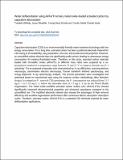| dc.description.abstract | Capacitive deionization (CDI) is an environmentally friendly water treatment technology with low energy consumption. For a long time, activated carbon has been a preferred electrode material for CDI owing to its availability, easy preparation, low cost, and tunable textural properties. However, an unmodified carbon electrode does not significantly prefer anions, leading to unnecessary energy consumption for treating fluoridated water. Therefore, in this study, activated carbon materials loaded with trimetallic oxides (Al/Fe/Ti) at different mass ratios were prepared by a co-precipitation method in a temperature range between 23 and 27 °C to improve fluoride ion (F−) selectivity. The as-prepared composites were characterized by X-ray diffraction, scanning electron microscopy, transmission electron microscopy, Fourier transform infrared spectroscopy, and energy-dispersive X-ray spectroscopy analysis. The process parameters were investigated and optimized based on experimental data using the response surface methodology (Box–Behnken design). In competitive F− removal CDI experiments, the F− concentration was reduced from 5.15 mg L−1 to 1.18 mg L−1, below the allowable limit of 1.5 mg L−1 set by the World Health Organization. The metal oxide-modified activated carbon surface (AC–Al4Fe2.5Ti4) showed significantly improved electrochemical properties and enhanced capacitance compared to the unmodified one. The modified electrode material also showed the advantages of high removal efficiency and excellent regeneration performance after continuous electric adsorption–desorption cycles. Therefore, activated carbon–Al4Fe2.5Ti4 is a potential CDI electrode material for water defluoridation applications. | en_US |

